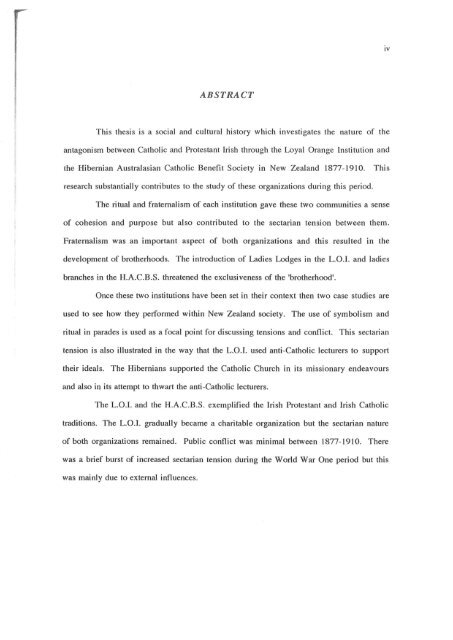TRANSPLANTED IRISH INSTITUTIONS - University of Canterbury
TRANSPLANTED IRISH INSTITUTIONS - University of Canterbury
TRANSPLANTED IRISH INSTITUTIONS - University of Canterbury
Create successful ePaper yourself
Turn your PDF publications into a flip-book with our unique Google optimized e-Paper software.
iv<br />
ABSTRACT<br />
This thesis is a social and cultural history which investigates the nature <strong>of</strong> the<br />
antagonism between Catholic and Protestant Irish through the Loyal Orange lnsti tution and<br />
the Hibernian Australasian Catholic Benefit Society in New Zealand 1877-1910.<br />
This<br />
research substantially contributes to the study <strong>of</strong> these organizations during this period.<br />
The ritual and fraternalism <strong>of</strong> each institution gave these two communities a sense<br />
<strong>of</strong> cohesion and purpose but also contributed to the sectarian tension between them.<br />
Fraternalism was an important aspect <strong>of</strong> both organizations and this resulted in the<br />
development <strong>of</strong> brotherhoods. The introduction <strong>of</strong> Ladies Lodges in the L.O.I. and ladies<br />
branches in the H.A.C.B.S. threatened the exclusiveness <strong>of</strong> the 'brotherhood'.<br />
Once these two institutions have been set in their context then two case studies are<br />
used to see how they performed within New Zealand society. The use <strong>of</strong> symbolism and<br />
ritual in parades is used as a focal point for discussing tensions and conflict. This sectarian<br />
tension is also illustrated in the way that the L.O.I. used anti-Catholic lecturers to support<br />
their ideals. The Hibernians supported the Catholic Church in its missionary endeavours<br />
and also in its attempt to thwart the anti-Catholic lecturers.<br />
The L.O.I. and the H.A.C.B.S. exemplified the Irish Protestant and Irish Catholic<br />
traditions. The L.O.1. gradually became a charitable organization but the sectarian nature<br />
<strong>of</strong> both organizations remained. Public conflict was minimal between 1877-1910. There<br />
was a brief burst <strong>of</strong> increased sectarian tension during the World War One period but this<br />
was mainly due to external influences.
















